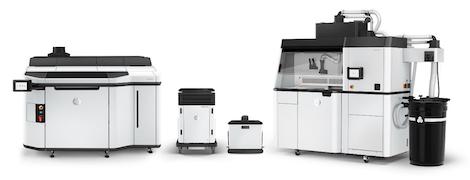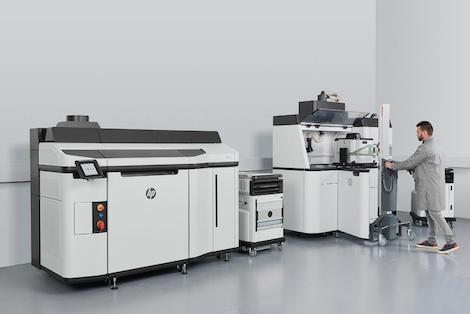
HP Jet Fusion 5200 from left to right: The 3D printer itself, the removable build chamber, a new Natural Cooling unit and the post processing station that handles part break out and powder recycling.
HP has made a raft of announcements around its 3D printing offerings, this time focussing on the industrial end of the spectrum – particularly interesting for organisations looking for a means of cost-effective additive manufacturing of polymer parts.
First, there’s a new advanced set of hardware in the form of the HP Jet Fusion 5200, which looks to bring together everything needed from the hardware side (in terms of build and post processing) along with some interesting software aspects. HP’s goal is to enable customers to ramp up their 3D production and target business growth.
It’s looking to accomplish this with high-quality parts and optimal yield of parts on an ‘industrial scale’.

The 5200 comprises of the build machine, build chamber, a cooling unit and a processing station. There are also some interesting add-ons that indicate this is intended for those looking to crank out the parts in their thousands, batch after batch.
Interestingly, the build envelope for this 3D printer isn’t that big (380 x 284 x 380mm) and there’s no word on whether these machines address HP’s process’ weakness in terms of packing density compared to its competition over at EOS.
That alone means that while you might be able to produce a chamber full of parts more quickly (up to 5,058 cm³/hr), you can’t fit as many parts into it as you can with other competitive systems.
There’s also talk of a new set of software solutions that ramp up the existing set of HP tools for those looking for more management and traceability in their workflow and processes.
Alongside the new machine launch (there’s a range of machines, according to the report from the fine folks at TCT, there’s also news on the materials front. While HP has its nylon variants, there’s a new certified TPU (thermoplastic polyurethane) from BASF called ULTRASINT for those looking for flexible parts.
There are a few claims that are also worth looking at in the accompanying launch site (https://www8.hp.com/us/en/printers/3d-printers/products/multi-jet-fusion-5200.html) – one is that this is looking to replace injection moulding in environments where you’re producing ‘over 200 parts per week’, but looking at the footnotes, it’s based on the caveat: “Part is 30 cm3 part at a 10% packing density using HP 3D High Reusability PA 12 material, up to 80% powder reusability ratio”.
Finally, HP has also teamed up with Siemens Digital Industries. For the last year or two, Siemens has been working hard on its additive manufacturing focused offering, from both support within its existing toolset as well as developing new sets of tools and services around the process.
While there’s a lot of talk of digital twins, industry 4.0 and more in the associated releases (you can read those here), it boils down to HP integrating its own 3D printing and 3D data platform with Siemens own toolset.
As an example, there will be a new module for NX called ‘NX AM for HP Multi Jet Fusion’ which will provide a direct printer interface to the new Jet Fusion 5200 machines available later this year, followed by similar for Teamcenter, Tecnomatix, Simatic and MindSphere for performance analytics and Industrial IoT.
Interested? Here’s the fancy voiceover-heavy video.
If you want to dig into more details, the brochure for the system is here






